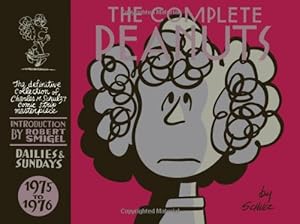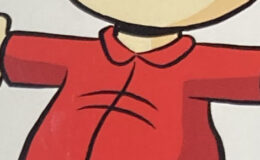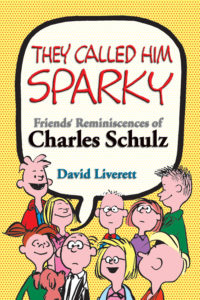The new volume of The Complete Peanuts is the start of the second half of the strip’s run, and (as the foreword by Robert Smigel accurately notes) it really does signal a switch in the series. The strip is less about anxiety, more about silliness. This is not a complete shift nor a permanent one; the strip evolved in the other direction in the 1990s.
The strips here tie in more to pop culture of the moment than in many of the previous volumes. Some of it is material that survives because the reference is still recognizable (there’s actually two separate references to Elton John), others less so (I can’t speak for you, but I certainly don’t recognize the name of characters from the British TV series Upstairs Downstairs.) One pop culture reference here is among my favorite, for totally nerd reasons: Snoopy watching a rerun of Hogan’s Heroes means that the name “Schultz”, spelled that way, appears in the strip. For all the time I see that mistakenly used as the spelling of “Schulz”, it’s funny to see it used appropriately in this context. (By the way, Starting next month the rotating strip gallery in the Schulz Museum will focus on the pop culture references in the strip.)
Romance takes various forms in here, with Linus and Snoopy making odd corners of a love triangle centered on Truffles, who looks like she belongs in a different strip. Marcie actually scorners a persistent suitor of sorts. Notable storylines includes the brief run of Joe Motocross, and the surprisingly long storyline where Peppermint Patty attends obedience school. Snoopy gets a family in this volume, first with the introduction of his brother Spike, and then bring in his sister Belle (and her teenage son, to boot!)
Toward the end of the book, there are lots of references to grandparents. Interestingly, while most of the characters talk about their grandparents in the present tense, Peppermint Patty talks of having had one; just another aspect of her relative parentlessness.
Frieda is cover-featured, which is a strange choice for this particular volume. “Do we still have a chance to win, Charlie Brown?”, “Yes, she does”, and “What kind of work do you do?” – that’s the sum total of Frieda’s dialogue over these two years. In other words, the few times she is used here, she’s used basically as a Generic Character To Say Something. No curly hair pride, no chasing rabbits, no floppy cat.
Take-away thought: a real World War I flying ace would not have been referring to himself as a World War I flying ace during that stage of his career, as “World War I” did not have that name until there was a World War II.
The Complete Peanuts 1975-1976 is available now.






